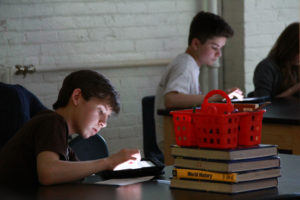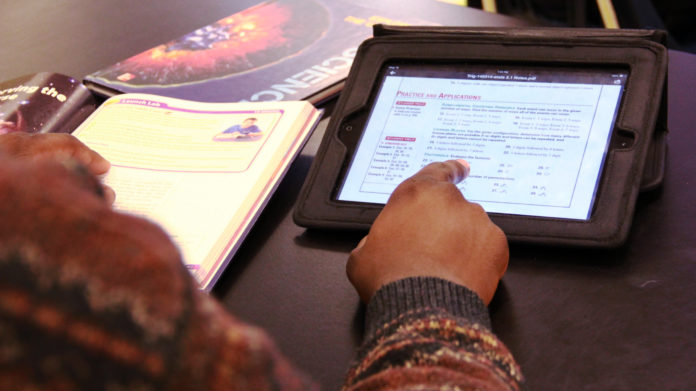Nick Mariano “lives and dies” by his iPad. He got his first one five years ago and won’t be seen at meetings, in conferences or at the front office without it.
As principal of Toledo School for the Arts (TSA), he dreamed of bringing the technology to students.
Last March, Mariano got his wish. After working with board members and diverting textbook funds, he equipped every student and teacher with an Apple iPad.
The device can be found in the hands of students everywhere in the charter school, from hallways and classrooms to studios where dancers review their choreographed moves.
The iPads initially cut down on paperwork and put information at students’ fingertips, but this winter, they did what teachers and Mariano could not have predicted: They allowed students and teachers to stay connected during subzero temperatures and school cancellations caused by the level three snow emergencies.
“With this being one of the harshest winters on record that caused most schools a loss of valuable teaching time, it was the optimal year to bring new technology into the classroom,” Mariano said. “Despite the snow, TSA was able to keep the educational process moving forward even though students were not in the building.”

During the polar vortex in January, students logged onto the school’s website to watch videos and find assignments. They posted homework, held discussions and created videos.
The iPads allowed the school to make up two snow days, and their success with students was evident, Mariano said.
“The sophomore class was given a project and 95 percent of the students completed it online and submitted it on time while home on a snow day,” he said.
The TSA board of directors decided to invest $117,000 a year for three years to lease 700 iPads as part of their plan to transition the school away from textbooks to iPads for all of its students, board member Rob Koenig said in an email.
The iPads were paid for by redirecting the school’s annual $100,000 textbook budget, Koenig said.
The iPad initiative “revolutionized” the school’s curriculum, he said, and readied students for state achievement tests which will soon be administered by computer or iPad only.
“The iPad deployment went extremely well and the new technology positively impacted the learning environment at TSA beginning on the first day of school,” Koenig said. “The faculty and students embraced this change quickly and the effect has been more powerful than we could have hoped.”
Mariano said the iPads have been so successful that students no longer use the school’s computer labs.
On March 17, two computer labs were devoid of students who were instead gazing into their iPads from their classroom desk or carting the device between classes.
Students said the device cuts back on what they have to carry and overall creates an easier learning experience.
“[The iPad] is definitely a great tool and learning experience for me,” said senior Tyler Fowler, who was a first-time iPad user. “We have to do [homework] anyway, the iPad made it a little more bearable.”
The iPads are being used for simple tasks such as “read the next chapter” as well as more difficult assignments like creating videos, Fowler said. During a snow day, he used it to write a paper after watching a documentary on slavery.
“I really like [the iPad]. It keeps me organized,” said sophomore Drew Longmore, who got her first iPad for Christmas a couple of years ago. “I am the biggest paper-loser ever.”
Longmore used the iPad to videotape her mother modeling clothes as Longmore voiced-over the names of the clothes in Spanish.
“I’m tech-savvy so I was really happy [to get an iPad],” said junior Roan Martin.
“I love typing rather than writing and all resources are in the same place.”
Martin said the school is teaching responsible use of the iPad. Administrators restrict email use and students are not allowed to download any apps.
“For the most part, students are very responsible,” Mariano said.
Mariano will be part of a group that will speak May 6 at Bowling Green State University on how to continue lessons during calamity days. The iPads as a learning tool will be a major part of that discussion, he said.
Students at Maumee Valley Country Day School, a private school in South Toledo, also use iPads as part of their curriculum, said teacher Lisa Behnfeldt.
The school purchased the devices two years ago and has put them in the hands of learners as young as 2 ½ years old up to 12th-graders, Behnfeldt said, who teaches first and second grades.
Every student in the middle school has their own device they can take home with them and other students use the iPad during the school day.
“It’s been two years so initially it was using the apps more as a tutoring usage — more as support — but now that we’ve had a couple years under our belt we’re using it more as a creative tool. It’s finding apps, creating books or creating math solutions,” Behnfeldt said.
Faculty had training on different ways to use the iPad in the classroom, she said, and the devices are stored and available within 10 feet of every instructor.
“[The iPads] are so user friendly for kids,” Behnfeldt said. “They figure out how to use them.”



